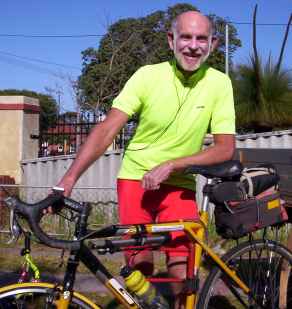This was replaced with a Cannondale R800 sport in
2005 which is an aluminium frame normal road bike but with
"hedshok" front suspension and a seat-post suspension. this was
much more comfortable for touring. I still ride this bike most
days in Darwin after more than 120,000 Km.
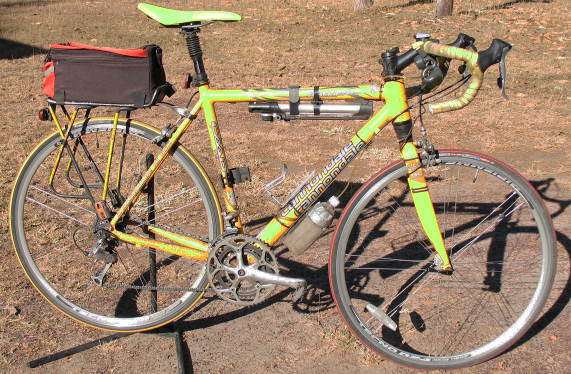
But these standard size 700c road bikes are hard
to pack/unpack for airline transport, so i purchased a folding
bike specifically for touring and ease of airline transport.
This bike came without a rack, so I made one
myself with short legs to keep the rack low. It also had to be
far back to allow space for pedaling with a pannier attached.
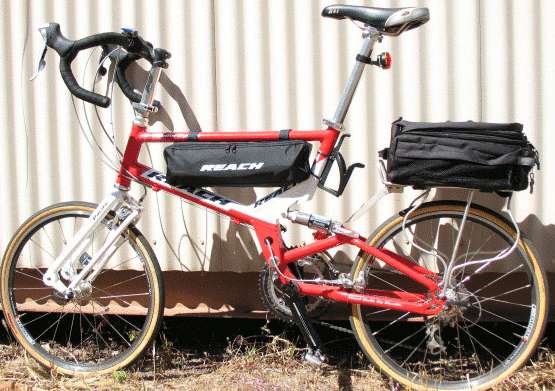
2008
This rack was not strong and required frequent repairs. It was
eventually replaced with a purchased "mountain" rack, which had
adjustable leg length and was more robust.
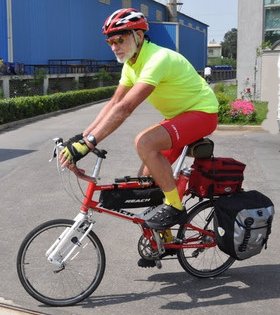
2011
Both these racks kept the pannier as low as possible to give a
stable ride even when carrying 20 Kg of luggage. But the rack
had to be removed when the bike was folded, making packing the
bike for travel complicated. After much practice, it took about
45 minutes to pack or unpack the bike for airline travel.
I used this bike for some 41,000 Km of touring including Europe,
Turkey, Taiwan, China, NZ and Australia.
But In August 2014 the frame broke!
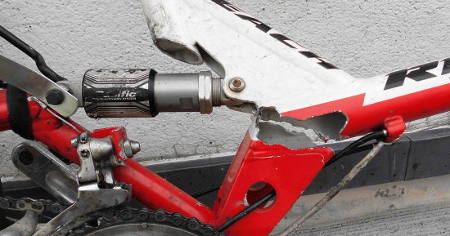
2014
I returned to the factory near Taipei to repair the bike. This
turned into a major issue, ending up with a new bike rather than
a repair.
My bike used the old style frame which is no longer made. But
the new style frame has some small but critical dimension
changes that made replacing the frame impossible.
The brake mounting bridges on the new frame are some 5 mm closer
to the tyre. This makes it impossible to use a 37mm wide tyre
and only 25mm wide tyres will clear the caliper brakes. But 25
mm rear tyres are not strong enough to carry the touring load. I
actually use a 37-451 tyre on the rear and a 25-451 tyre on the
front.
I had to change frames from the "Reach-road" to
the "Reach-trail" so i could use a 37mm wide tyre. But
this frame does not have bridges for caliper brakes and is built
only for V-brakes. These brakes are incompatible with road type
shift-brake levers, so I also had to change to flat handlebars
with mountain brakes and shifters. However the "trail" frame
does have a built-in folding rack which is much more convenient
than putting a separate rack on the "road" frame.
After much re-construction at the factory, where they were
extremely helpful, I completed my Japan and China tour on this
new bike.
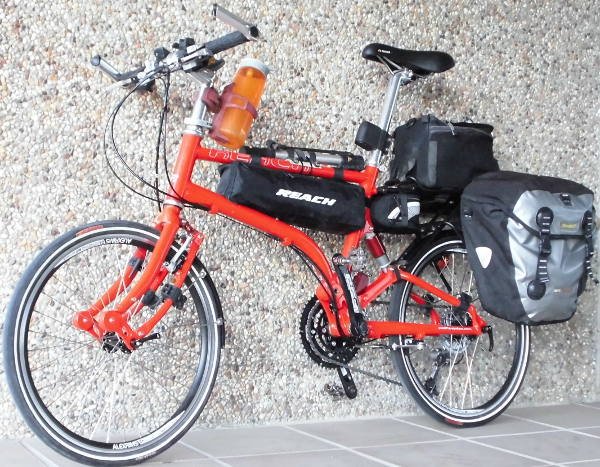
August 2014
But I find flat bars less comfortable than drop bars. On the
very bad roads in China i had to keep my hands on the brake
levers and could not relax and use the bar-ends. Drop bars allow
a comfortable wrist position while still giving access to the
brakes and gearshift. In addition, the V-brakes are a pain to
maintain proper adjustment and extremely annoying during packing
and unpacking the bike for airline transport.
I decided to banish the flat bars somehow. I experimented
with bullhorn bars and road levers, but still found these
uncomfortable, so I have now used standard drop bars.
The main issue is the brakes. Road brake levers pull only half
as much cable as mountain levers. One solution is to use
"travel-agents" which double the cable pull. But it is
impossible to mount these securely on a bike which folds. The
other solution is to use "mini-V-brakes". It happens that the
bike actually does have "mini-V-brakes" (Tektro RX5) and these
do work (just) with road levers. (Genetic also make suitable
mini-V-brakes.) You have to keep the wheel true and the brake
pad clearance low and then road levers can work. A major problem
with V-brakes is balancing the travel of the two pads. I found
that the problem is poor lubrication and/or dirt in the mounting
stems of the brake arms. Once I cleaned and carefully lubricated
the brakes I could balance the travel properly. To prevent road
grime from entering the bushings I cut a 3 cm. length from an
old 700-25 tube and used it as a protective sleeve over the
brake mount bushings. There is no adjusting screw on these
brakes, so I added in-line barrel adjusters in each brake cable.
Another issue is trying to release the brakes for wheel removal.
The pad-rim clearance is so little that you cannot release the
noodle from the toggle to open the brakes. I made a 3mm thick
washer and placed this on the noodle tip so that you now only
need about 1mm of compression to release the noodle from the
toggle. Now you can open the brakes to allow wheel removal.
The CB90 cable adjuster/release
There is a better way to allow for brake adjustments. I have now
installed a pair of Shimano CB90 "brake cable adjusters".
These are an in-line adjusters with an inbuilt release lever.
The release lever mechanism gives 5mm of cable release to allow
opening the brakes for wheel removal. The screw adjustment
provides 10mm of tension adjustment. With these, there is no
need to put a washer on the noodle. But you do need a slightly
thinner than usual ferrule on the cable so it does not jam when
you open the release lever.
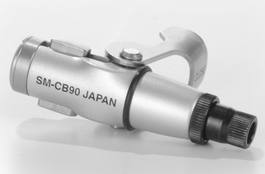
I was also unhappy with the stiffness of the rear suspension. I
opened up the shock absorber (which is easy to do) and filed
down the elastomer 1 or 2mm in a wide shallow groove. This gave
a noticeably more compliant ride without being too "loose". Be
careful if you do this, you do not need to remove very much
material to change the ride significantly and the amount will
depend on your weight and touring load.
After all this fiddling I now have my preferred road
brake-shifters and drop bar on the bike.
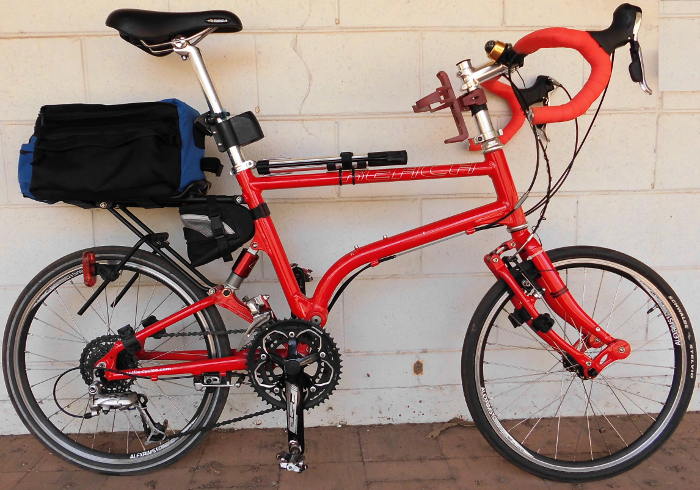
October 2014
It has been a complex process to sort this out, but I like this
much better.
The gears work just fine. My concern is the brakes and the
need to maintain a very small clearance between the brake pads
and the rim and the need to keep the rim very true. Will this
become an issue when touring rough roads with a touring load?
UPDATE - Jan 2015
After riding
1500 Km in the Adelaide
region in January 2015, the clearance between the brakes
and rims was not an issue, and the wheels did not need to be
trued.
The CB90 cable adjusters were very
useful and helped deal with the 5 punctures I had to repair on
the rear wheel. It is now easy to remove and replace the wheels
in correct alignment, although the tyres must be deflated. With
the CB90 cable adjusters it is not necessary to remove the
V-brake noodle, an annoyingly fiddly task.
In 2018 I added another bike. The Cannondale Slate has
fat 42mm tyres and is great for riding gravel roads without
compromising paved road speed much, if at all. But this bike is
not intended for touring as it does not fold for easy transport
on aircraft. It has an aluminium frame, front suspension and
hydraulic disk brakes.

 Applied Mineral Exploration
Applied Mineral Exploration Discussion and research relevant to mineral
exploration.
Discussion and research relevant to mineral
exploration. 